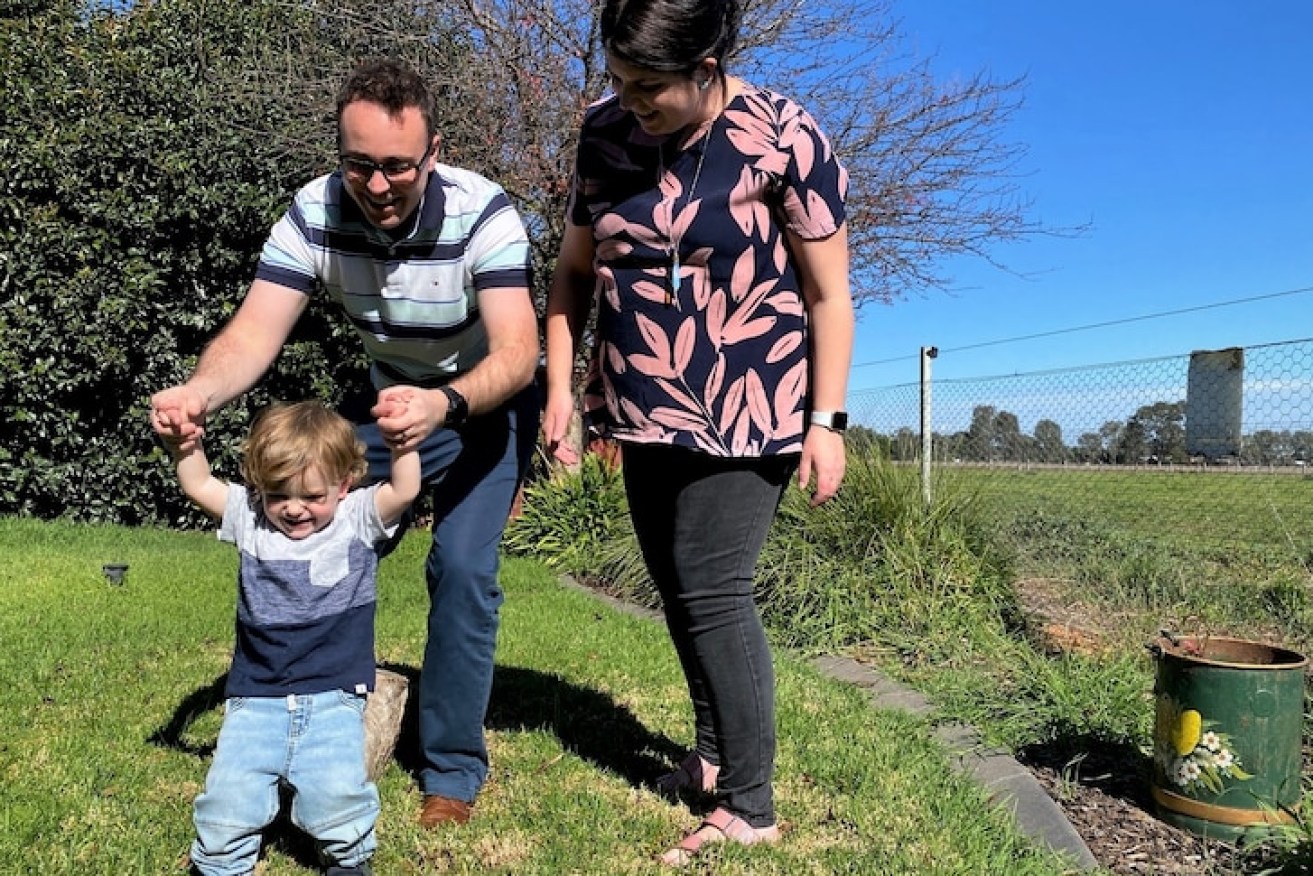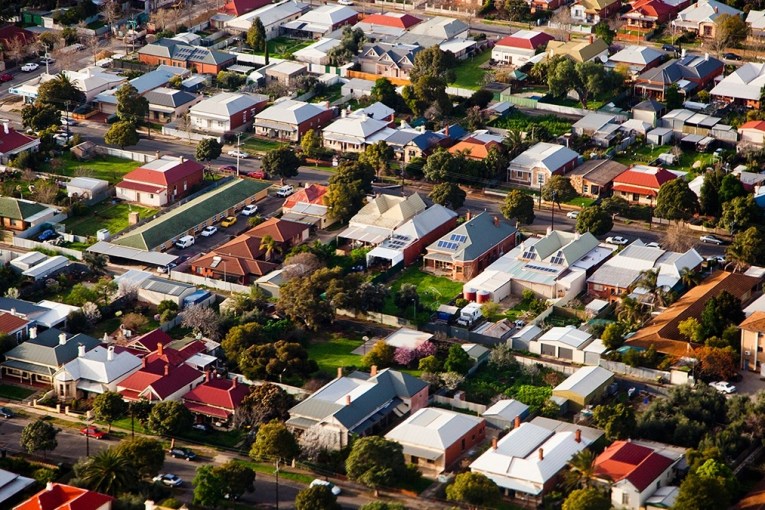‘Bit of a culture shock’: COVID-19 made a tree change alluring – but that trend may not last

Jessica and Geoff Zach have moved from Melbourne to Wangaratta with their young child Teddy. Photo: Emilia Terzon
A tree change has never been more alluring but population experts believe some city dwellers going regional during the pandemic will find “it’s not all it’s cracked up to be” and the migration trend won’t last long term.
We all know the story by now.
Historically, Australia is a highly urbanised country. But the explosion of working from home during the pandemic and the ongoing threat of snap lockdowns in big cities such as Melbourne have made a tree change more feasible for city folk.
Reports of soaring property prices in regional lifestyle towns favoured by urban movers are now commonplace.
So, too, are the headlines about a city exodus during COVID-19.
What does the population data say?
The latest ABS data showed regional Australia experienced a net inflow of 43,000 people from the capital cities in 2020. That was the highest number since reporting began two decades ago.
However, ANU demographer Liz Allen cautioned this top-line figure hid a more complicated picture.
The net figure represents the total number of people moving to the country minus the number of people leaving it for the big cities.
Location, location, location
During COVID, the net inflow has soared not only because people are moving away from the cities, but also because more regional Australians are staying put in their country towns.
“We aren’t seeing the flows of people back into the city areas,” Dr Allen said.
“That [trend is] something that we’ve seen in Australia, but it’s being reflected in major cities and other capitals across the world.”
There is still not a huge amount of data showing exactly where city people have moved during the pandemic.
Property prices hint tree changers are seeking places still relatively close to major capitals, such as the Central Coast near Sydney or the Surf Coast near Melbourne, rather than truly remote locations.
“It’s unlikely that we’re seeing major shifts many kilometres out from the city regions,” Dr Allen said.
“What we’re likely to be witnessing at the moment is small moves that allow people to still be connected to the city limits while also achieving a lifestyle.”
What are people finding once they move?
ABC News travelled to Wangaratta in northern Victoria, 250 kilometres north of Melbourne, just before the state’s latest lockdown to meet families who had moved there during the pandemic.
The Zachs made the move to a rural block on the outskirts of the regional town after being stuck in their small Melbourne home during the city’s extended lockdown last year.
“We were really cooped up,” Jessica Zach said.
Ms Zach grew up in regional Victoria. Her family is still there too, so for her the move was more of a country homecoming after spending much of her adult life in Melbourne.
And that’s not unusual for tree changers. Ongoing research by the Regional Australia Institute suggests many people who make the move from big cities to the country usually have existing ties to where they are relocating.
Ms Zach’s husband, Geoff, on the other hand, had never lived outside of a big city before and had been resisting Jessica’s pleas for a tree change for years. However, he said: “COVID pushed it through.”
No traffic hassles
So far, he’s enjoying it.
“There’s no traffic lights to get to work,” he said.
“It sounds silly, but I’ve been able to go out to a farm and chop up some wood, which is not what you do in the city.”
But there have been some stressful moments.
The family decided to move to Wangaratta after Mr Zach found a new job at a local firm. After years of chatter about housing being more affordable in the regions, they thought finding a rental would be easy.
“There were only three rental properties in the whole greater Wangaratta area,” Ms Zach said.
CoreLogic data shows Wangaratta is one of the many regional Australian property markets that have significantly tightened during the pandemic, with prices up 7.2 per cent in the year to April 2021.
“The strong rise in rents has been accompanied by a relative shortage in listings stock, as migration flows away from the area likely slowed down during the pandemic,” CoreLogic analyst Eliza Owen said.
That is where understanding the true nature of the net migration trends across Australia becomes important.
Homes in short supply
Blaming a housing crisis on new arrivals is convenient but it misses the story of less housing stock being available to begin due to more people staying put during the pandemic.
The Zachs eventually found a rental home on the outskirts of Wangaratta with help from Mr Zach’s new employer.
“We were very lucky,” Jessica said.
The couple want to stay in the region long term, but say settling into the community and being able to find stable housing could affect their decision.
“We’re happy right here at the moment, but long term we’d ideally like to buy,” Ms Zach said.
“I think we’ll just give it a go and see what happens and see if we like it. See how we fit into the community.”
Some tree changers finding service gaps
The Sear-Pirko clan is another young family that has moved to Wangaratta from Melbourne during the pandemic.
Parents Denise and Jeremy made the move with their two young children after feeling cooped up in the big smoke, losing contract work during the pandemic, and wanting to be closer to Mr Sear-Pirko’s oldest child in northern Victoria.
Like the Zach family, they were shocked by the region’s housing shortage. They now feel lucky to have landed a rental home and jobs in the rural city of fewer than 30,000 people.
“It’s a lovely spot. It’s got all the facilities you need, but it’s also not crowded,” Mr Sear-Pirko said.
But they have noticed some service gaps they did not face in Melbourne.
They said Wangaratta’s medical clinics had long waiting lists and they had struggled to get into any bulk-billing centres.
“Some of their websites actually say we’re not taking on new patients,” Ms Sear-Pirko said.
Mr Sear-Pirko said it was “at the point” where the family was still having online telehealth appointments with their Melbourne doctor.
There is also little public transport in the area, except for buses that do not run frequently on weekends. That is difficult for a young family with only one car.
“That’s a bit of a culture shock,” Mr Sear-Pirko said.
“In the old days we lived near a station. We could get on the train [and] be in the city in 14 minutes.”
But they have found some surprising advantages to their new home. For instance, they have found childcare places for their two young children easier to get in Wangaratta than in Melbourne.
“We found space at a daycare that can take them both and was really flexible,” Ms Sear-Pirko said.
The couple are committed to their new life in Wangaratta but acknowledge it will take adjustment.
“I don’t know if everyone has a really realistic expectation of what they’ll have when they get here,” Ms Sear-Pirko said.
“And I don’t know if everyone can handle the changes of what it’s really like when they’re really here.”
Will people stay long-term?
The difference between the availability of services in capital cities and regional Australia is well known.
There are staggering gaps in services and health outcomes for people, particularly Indigenous Australians, who live in remote areas.
However, research conducted by the Grattan Institute over the years suggests claims about there being “two Australias” – big cities and regions – is over-simplified.
Grattan Institute economic policy program director Brendan Coates said the “short of it” was that incomes were lower in regional Australia, but growing just as quickly as urban Australian pay packets.
He also noted people outside of big cities actually reported higher overall levels of wellbeing.
“There’s a good news story here in that people are happier in regional living,” Mr Coates said.
“But the costs of providing services in regional areas are much higher, [with it] simply more expensive to provide due to economies of scale.
“Things like services from councils are also harder to provide in regional Australia because there isn’t the same ability to draw in skilled employees.”
The ANU’s Liz Allen agreed that, to some extent, the differences in services were due to what could be delivered in towns with simply far fewer people than big cities.
“There’s most definitely an economic side to the demand for services,” she said. “Money flows with demand.
Downturn ahead?
“Of course, the problem with that is that we see a disconnection between the health outcomes of people living across different geographies in Australia.
“That’s something we need to tackle and address.”
But she said the current strong flow of people to regional areas was unlikely to last.
“Many are rejoicing at the idea of people settling in regional areas. Certainly, mayors and other politically minded people that are located in regional areas are looking at this movement as a bit of a triumph,” Dr Allen said.
“It’s unlikely to be long lived though.
“After COVID is over, we’re likely to go back to the trend that sees capital cities remain quite strong and a net flow into the capital cities.
“And that’s because the vital infrastructure and services are in existence there and they’re established and they’re quite functional.
“I think many people moving to the regional areas will soon discover that it’s not all that it’s cracked up to be.
“That’s because the infrastructure is lagging in the regional areas in comparison to what we have in the city areas.”








